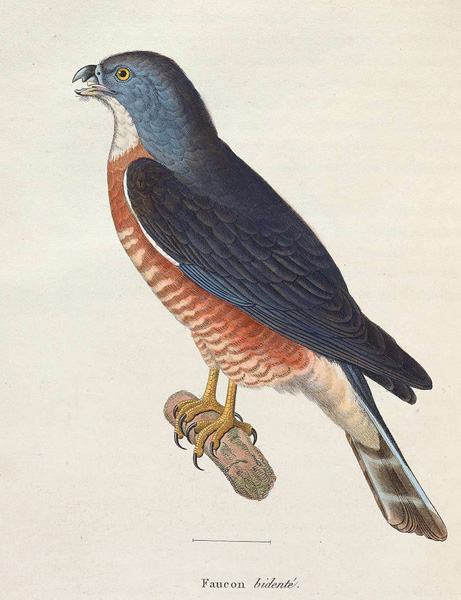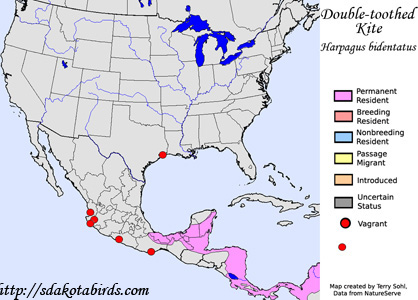| Length: 14 inches | Wingspan: 25-28 inches | Seasonality: Non-resident in South Dakota |
| ID Keys: Dark gray back, head, and wings, white throat with dark central stripe, rufous underparts with light horizontal bars, white rump in flight | ||
 The
Double-toothed Kite is so named for "tooth" like structures on the edge of
each side of the upper mandible (see painting to the right). They are
a species normally found in Central and South America, with the northernmost
part of their normal range just reaching southern Mexico. They are not
migratory and are not expected to be found in the United States.
However, on May 4th, 2011, Mr. Dave Hanson took a photograph of a bird in
Galveston County, Texas, a bird he initially presumed to be a Cooper's Hawk.
Upon looking through his photos a month later, there was speculation it
might be something else. Conferring with experts, it was found that the
clear photo was of a young, 1st-year, female Double-toothed Kite. The
next year, the American Birding Association (ABA) added the Double-toothed
Kite to the official checklist of species that have been seen in the North
American region.
The
Double-toothed Kite is so named for "tooth" like structures on the edge of
each side of the upper mandible (see painting to the right). They are
a species normally found in Central and South America, with the northernmost
part of their normal range just reaching southern Mexico. They are not
migratory and are not expected to be found in the United States.
However, on May 4th, 2011, Mr. Dave Hanson took a photograph of a bird in
Galveston County, Texas, a bird he initially presumed to be a Cooper's Hawk.
Upon looking through his photos a month later, there was speculation it
might be something else. Conferring with experts, it was found that the
clear photo was of a young, 1st-year, female Double-toothed Kite. The
next year, the American Birding Association (ABA) added the Double-toothed
Kite to the official checklist of species that have been seen in the North
American region.
Habitat: Found in tropical to sub-tropical forest lands, including primary forest and previously disturbed secondary forest. Within these habitats they are often found in and around forest edges and clearings.
Diet: Feeds heavily on insects and lizards, but may also feed on other small vertebrates if the opportunity arises. Some individuals are accomplished at catching bats in flight, and young birds may also make up a significant portion of the diet in some seasons and locations.
Behavior: Double-toothed Kites are often found in the vincinity of troops of monkeys in their native range. As the monkeys move through the forest canopy, they disturb insects, lizards, birds and other small prey, and the Double-toothed Kite takes advantage and feeds on them.
Nesting: The nest of a Double-toothed Kite is a shallow saucer-shaped structure placed in the fork of a tree. The female usually lays 2 eggs, which are incubated for approximately 6 weeks. The female incubates the eggs and also does the majority of caring for the young after they hatch, although the male will sometimes deliver food items to the next. The young fledge from the next about one month after hatching. The young remain dependent upon the parents for another month or two after fledging.
Song: Multiple vocalizations, including a high-pitched, whistled "tsee-up tsee-UP" and a rapidly paced tsee-tsee-tsee-tsee-tsee given in flight. They are often a very vocal species, particularly during the breeding season.
Migration: Considered a permanent resident throughout its range, with only short-distance movements.
Interactive eBird map: Click here to access an interactive eBird map of Double-toothed Kite sightings
Similar Species: In overall structure, they are similar to the Accipiter hawks such as Cooper's Hawks or Sharp-shinned Hawks. If seen well, however, plumage differences are obvious, particularly in flight where a white rump patch is easily seen.
Conservation Status: There have undoubtedly been declines in overall numbers in recent decades, due to deforestation and other habitat loss throughout much of its range. However, they are still found over a broad geographic area and are relatively common in parts of their range. The IUCN lists the Double-toothed Kite as a species of "Least Concern".
Further Information: 1) Cornell's NeoTropical Birds - Double-toothed Kite
2) BirdLife International - Double-toothed Kite
3) Texas Birds Records Committee - Double-toothed Kite
Photo Information: Public domain image from Nouveau recueil de planches coloriees d'oiseaux A Strasbourgh: Chez Legras Imbert et Comp., 1838.
| Click below for a higher-resolution map |
 |
| South Dakota Status: Non-resident in South Dakota |
Additional Double-toothed Kite Photos (coming soon!!)
